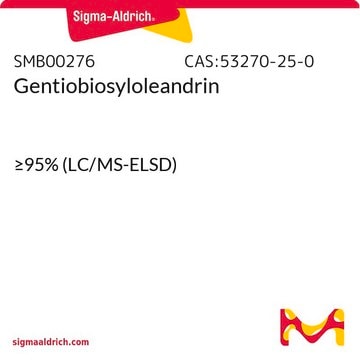J3705
JB1 trifluoroacetate salt
≥98% (HPLC)
Sinónimos:
H-Cys-Tyr-Ala-Ala-Pro-Leu-Lys-Pro-Ala-Lys-Ser-Cys-OH trifluoroacetate salt, JB-1 trifluoroacetate salt, L-Cysteinyl-L-tyrosyl-L-alanyl-L-alanyl-L-prolyl-L-leucyl-L-lysyl-L-prolyl-L-alanyl-L-lysyl-L-seryl-L-Cysteine, cyclic (1-12)-disulfide trifluoroacetate salt
Seleccione un Tamaño
MXP 3,725.00
Fecha estimada de envío26 de abril de 2025
Seleccione un Tamaño
About This Item
MXP 3,725.00
Fecha estimada de envío26 de abril de 2025
Productos recomendados
Nivel de calidad
Ensayo
≥98% (HPLC)
Formulario
film
condiciones de almacenamiento
desiccated
Condiciones de envío
wet ice
temp. de almacenamiento
−20°C
cadena SMILES
CC(C)C[C@@H]1NC(=O)[C@@H]2CCCN2C(=O)[C@H](C)NC(=O)[C@H](C)NC(=O)[C@H](Cc3ccc(O)cc3)NC(=O)[C@@H](N)CSSC[C@H](NC(=O)[C@H](CO)NC(=O)[C@H](CCCCN)NC(=O)[C@H](C)NC(=O)[C@@H]4CCCN4C(=O)[C@H](CCCCN)NC1=O)C(O)=O
InChI
1S/C55H88N14O15S2/c1-29(2)24-38-49(77)63-37(13-7-9-21-57)54(82)69-23-11-14-42(69)51(79)60-31(4)45(73)62-36(12-6-8-20-56)47(75)66-40(26-70)50(78)67-41(55(83)84)28-86-85-27-35(58)46(74)64-39(25-33-16-18-34(71)19-17-33)48(76)59-30(3)44(72)61-32(5)53(81)68-22-10-15-43(68)52(80)65-38/h16-19,29-32,35-43,70-71H,6-15,20-28,56-58H2,1-5H3,(H,59,76)(H,60,79)(H,61,72)(H,62,73)(H,63,77)(H,64,74)(H,65,80)(H,66,75)(H,67,78)(H,83,84)/t30-,31-,32-,35-,36-,37-,38-,39-,40-,41-,42-,43-/m0/s1
Clave InChI
MPUVBZQBFGGAAS-XHGDPFBQSA-N
Acciones bioquímicas o fisiológicas
Características y beneficios
Código de clase de almacenamiento
11 - Combustible Solids
Clase de riesgo para el agua (WGK)
nwg
Punto de inflamabilidad (°F)
Not applicable
Punto de inflamabilidad (°C)
Not applicable
Elija entre una de las versiones más recientes:
Certificados de análisis (COA)
¿No ve la versión correcta?
Si necesita una versión concreta, puede buscar un certificado específico por el número de lote.
¿Ya tiene este producto?
Encuentre la documentación para los productos que ha comprado recientemente en la Biblioteca de documentos.
Artículos
We offers many products related to InsR for your research needs.
Active Filters
Nuestro equipo de científicos tiene experiencia en todas las áreas de investigación: Ciencias de la vida, Ciencia de los materiales, Síntesis química, Cromatografía, Analítica y muchas otras.
Póngase en contacto con el Servicio técnico




